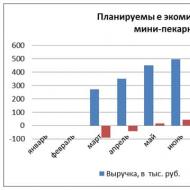
Stakeholder management: management of interested groups. Stakeholders are... The influence of stakeholders on the project
The concept of a stakeholder (interested person, interested party) in a business as a whole or in some individual business project, as an individual or legal entity that can positively or negatively affect the conduct of business or the progress of a project, is intuitively known to every business leader, every manager project.
The concept of stakeholders and the principles of working with them have been systematically presented in the works of Western researchers.
The concept of stakeholder, which is much broader, is sometimes confused with the concept of shareholder (Shareholder or Stockholder). The authors of the “Stakeholders” section of the 12manage.com website include the following as the main groups of stakeholders:
- shareholders and investors;
- creditors: banks and other credit organizations;
- partners and suppliers;
- buyers and clients;
- managers and senior management of the company;
- company personnel;
- trade unions;
- competitors;
- government and tax authorities;
- professional associations;
- mass media;
- non-governmental organizations;
- public environmental, religious and other organizations;
- local communities.
Obviously, this impressive list does not exhaust the list of all individuals or legal entities that can affect business. The concept of stakeholders, who form both the economic and human, psychological environment of a business or an individual project, is so important that the famous management specialist Edward Freeman formulates the key and only goal of any organization as achieving a balance of interests of stakeholders (quoted in).
The concept of stakeholders becomes absolutely critical in project management, where the environment is characterized by high dynamism. The corporate project management methodologies of some large companies require that key project stakeholders and their requirements for the project be listed in the project baseline (usually in the “communications plan” section). Here's how David Cleland defines the concept of project stakeholders:
Stakeholders (interested parties, shareholders) of a project are people (organizations) or groups of people who have, or believe that they have, legal claims regarding some aspects of the project. The purpose of interest may be to ensure personal interest, a share in participation, or to put forward requirements for the project; this goal can vary from satisfying informal interests in the process of participation in the project to making legal claims.
The quoted definition implicitly contains a very important idea: the attitude of one or another interested person to the project is characterized not only (we allow ourselves to focus the reader’s attention on this) and not so much by objective economic prerequisites, but, on the contrary, by a subjective attitude towards the project, business as a whole or (which is very critical) to the leader of this business or project manager.
The literature describes quite well the tools for analyzing stakeholders at an objective level: division into internal and external stakeholders, primary and secondary, “influence-dynamism”, “influence-interest” matrices, and so on. The tools and approaches we offer are a development of the ideology of stakeholder analysis of the consulting company Strategic Management Group (SMG) and, to a certain extent, are focused specifically on personal psychological analysis of the environment of a business or an individual project.
Analysis of any group of objects, events or phenomena (such as operational or project risks in risk management) begins with their identification. Stakeholder analysis can be carried out independently by the business or project leader, in the process of personal consultation with a consultant or coach, as well as in a group format (for example, at a meeting of the Core Project Team - the project coordination group). In the latter case, if group members do not know the stakeholder analysis tools, they need the help of an experienced facilitator, whose task is not to offer ready-made solutions to the group, but to manage the analysis process and explain the “subtle” aspects of working with the tools.
Both the leader and the group, not to mention consultants and facilitators, should form a clear understanding that the use of stakeholder analysis tools does not provide any additional information about the environment of the business or project, but only allows you to systematize what is already available, sometimes transferring it from subconscious level to the level of conscious perception and, based on this systematized, “sorted out” information, outline an adequate strategy for working with stakeholders. Therefore, all the proposed tools are essentially tools for visualizing information about the environment of a business or project, allowing you to transfer information from “subconscious” to “conscious codes”.
In this work we will look at four tools that have proven themselves in practice:
- stakeholder's map,
- interest table,
- matrix “support × power of influence”,
- an integral measure of assessing the business environment (or project environment) - Alexey Pirogov’s formula.
The last formula was developed during a training with employees of Probusinessbank, conducted by the first of the authors. The assessment methodology contained in this tool was proposed by the vice-president of Probusinessbank, Alexey Pirogov.
A stakeholder map is a tool that allows you to most adequately identify stakeholders. The very concept of “map” leads us to the question of the relationship between symbol and object. There is a well-known expression by Alfred Korzybski, who laid the foundations of general semantics, widely quoted by theorists and practitioners of neurolinguistic programming: “The map is not the territory.” That is, an abstract construction derived from an object, or the subject’s reaction to it, is not the object itself. Thus, the stakeholder map is a subjective representation (image) of an individual (leader) or group about the business environment or project environment. This image is displayed graphically in the form of some diagram (drawing). The process of identifying stakeholders is somewhat meditative. If the work is carried out in a group format or in the format of personal consultation, then the facilitator or consultant suggests presenting to the group (or the person being consulted) the sky, in the center of which the leader (“luminary”) is placed. Stakeholders are the equivalent of “stars” in the sky. At this stage, the main task is not to let out of sight stakeholders, individuals or legal entities that can have a positive or negative impact on the conduct of business or the implementation of the project. Brainstorming technology (for example,) is applicable to the process of identifying stakeholders in a group format. At the same time, each participant in the session develops his own visual picture of the business or project environment. Some of the “stars” turn out to be closer to the “luminary”, some further. Here the consultant or facilitator should ask the question on the basis of what principle the participants in the session placed stakeholders in one or another proximity to the leader. As a rule, the answer given by session participants is: “The more important this or that stakeholder is to us, the closer we place him to the leader.” The principle traditionally embedded in the visual image of the stakeholder map is completely opposite to what is declared - the degree of proximity expresses the degree of the leader’s ability to influence a particular stakeholder.
In fact, three concentric areas are distinguished on the mental map (Fig. 1):
- Area of authority/responsibility. This area contains stakeholders who report directly to the leader. And the most primitive strategy for the relationship between a leader and a given stakeholder may be administrative coercion (order). It must be well understood that many projects, especially in large organizations, are carried out within the framework of the so-called weak matrix organizational structure, when members of the project team are not functionally subordinate to the project manager. In this case, this area may appear empty when analyzing the project environment.
- Area of direct influence. There are interested parties here who are not subordinate to the leader, however, in accordance with his status, the leader can use the strategy of resource exchange (“you to me, I to you”) or persuasion when building relationships with them. At the same time, outright manipulation cannot be ruled out. When applied to project management, the area of direct influence includes members of the project team who are not functionally subordinate to the project manager, other company employees whose hierarchical status is not much higher than that of the manager, the project supervisor, suppliers and contractors (if the manager works with them directly) , clients of the company (if the manager works with them directly).
- Area of indirect influence characterized by the fact that the leader is practically deprived of tools for direct influence on this stakeholder. The very meaning of the adjective indirect indicates that in order to influence a stakeholder, the leader is forced to use the support of a stakeholder located in his area of authority or in the area of direct influence. In a typical situation in this area, project management in relation to the project manager may include the project sponsor, almost the entire top management of the company, representatives of government agencies, and competitors.
 Rice. 1.
Rice. 1.
As you might guess, the formal list of stakeholders in the environment of a business or project is huge, and when visualizing a stakeholder map graphically (for example, when depicted on a flip chart during group work), a geometric breakdown based on the “nearer - further” principle can greatly complicate the picture. It is recommended to connect the leader figure (“luminary”) with stakeholders (“stars”) using triple (area of authority/responsibility), double (area of direct influence) or single (area of indirect influence) lines, neglecting the original geometry (Fig. 1 and 2) . Thus, the number of lines n = 1,2,3 characterizes the degree of possibility of the leader’s influence on the interested party.
As usually happens when using brainstorming technology, the resulting stakeholder map may contain unnecessary, unimportant information. The method for cutting off “noise” information is an expert assessment by the person being consulted or by a group of “importance parameters” of interested parties.
 Rice. 2.
Rice. 2.
“Importance” is assessed on two scales (x / y in Fig. 2), where x = -5 ÷ +5, with a step of 1 (or smaller) characterizes the degree of support/opposition by a stakeholder for a project, a business as a whole, or a leader personally(! ), (–5 is the extreme degree of opposition, +5 is the highest degree of support), y = 0 ÷ 5 with a step of 1 (or smaller) characterizes the degree of influence of the stakeholder on the project, business or leader. At the same time, one should not mechanically cut off stakeholders with zero values for the degree of support / opposition or power of influence, since, as we will see later, zero values can be triggers (signals) of risks emanating from the project environment.
It must be borne in mind that the leader himself is the most important stakeholder and must give a self-assessment according to the x / y parameters, which will show (in case of sufficient frankness with the consultant, group and facilitator) the degree of his interest in the business (project), as well as a subjective assessment of the possibility of management this business or project.
It is the diagram presented in Fig. 2, and in the classical interpretation is called “stakeholder map”.
For small companies doing business locally, the power of influence of internal stakeholders in relation to the manager of an individual project, all other things being equal, can be assessed in accordance with the following principle:
- y = 5 – top officials of the company (president, general director, members of the board of directors),
- y = 4 – second persons of the company (vice presidents),
- y = 3 – heads of functional departments,
- y = 2 – middle managers,
- y = 1 – line managers.
This principle obviously stops working if we are talking about a large, geographically distributed holding company.
A stakeholder map built in this way allows you to visualize the threats emanating from the project environment. Let's look at Fig. 2. As for the threats from the “competitors” stakeholder, they are completely obvious. The situation with the “government agencies” stakeholder is less obvious. The attitude of the stakeholder “government agencies” towards the business or project is weakly negative (x = -2), the power of influence is quite noticeable (y = 4), and the possibility of the leader’s influence on this stakeholder is minimal (n = 1).
The stakeholder map shown in Fig. 2 is illustrative in nature, therefore those who use this tool for the first time should be warned against the temptation of an overly “enlarged” representation of stakeholder groups (“public”, “government agencies”, “suppliers”, etc.) It is clear that within a certain group there are legal entities (organization A or organization B) will have completely different “importance parameters”. At the same time, as for legal entities, it is extremely useful to indicate the decision makers (individual decision makers) on the diagram.
It is also worth paying attention to one sensitive aspect. Drawing a stakeholder map for a business or project demonstrates the leader's understanding of his or her environment. Although, as we have noted, work with this tool can be carried out in a group format, this “understanding” should not be made public, for example, within the organization as a whole. If the leader (project manager) evaluates two status persons of the company, for example, +3/4, 0/3, then there is a great risk that the latter will try to demonstrate to the hapless leader the power of his influence on the project, significantly exceeding his real powers.
The schematic diagram of working with the stakeholder map is shown in Table. 1.
| Actions | Questions |
|---|---|
| Formulate business goals or project goals. Identify stakeholders. | Do all stakeholders understand the goals of the business/project in the same way? |
| Construct a stakeholder map and determine the degree of possibility of influencing stakeholders (n = 1,2,3). | If the possibility of influence is insufficient, what is the reason? No appropriate authority or contact with this stakeholder? |
| Assess the strength of stakeholder support/opposition for a business or project (x = -5 ÷ +5). | What are the interests of the stakeholder in relation to the business/project? |
| Assess the strength of the stakeholder’s influence on the business or project (y = 0 ÷ 5). | Does the resulting expert assessment follow a natural “hierarchical structure”? |
Table 1.
The tools listed along with the stakeholder map in the list above (interest table and support × influence matrix) are often considered as auxiliary, but they carry additional semantic load.
Let's consider the principles of using the table of interests (Fig. 3). The information obtained during the construction of the stakeholder map, of course, can be presented in tabular form. At the same time, based on the obtained assessment of the degree of support/opposition by a stakeholder for a business or project, an assessment of the strength of his influence on the business or project, as well as an assessment of the possibility of influencing the stakeholder, a strategy for interaction with this stakeholder can be developed. However, often (especially if the leader uses the described tools without the help of a consultant) these assessments are formed based on completely formal considerations. For example, at meetings of project groups dedicated to the analysis of the project environment, you can hear the following statements: “The president of the company supports this project (x = +5), since the project is aimed at introducing an innovative product to the market that promises fabulous profits for the company.” In this case, not only the conclusions of professional experts who gave a negative assessment of the technological or marketing component of the project, but also the personal attitude of the company’s top person to the project may be ignored.
 Rice. 3.
Rice. 3.
In the table of interests, the columns “stakeholder interests” and “tools of influence” play an important role. These columns represent a kind of test for the consistency of the estimates given. If the information in them corresponds to the true state of affairs, then the resulting expert assessments will be adequate. In addition, understanding the interests of a stakeholder and describing the tools of his influence on a business or project will help develop an optimal strategy for interacting with him.
The “support × influence force” matrix is an xy coordinate system on a plane on which stakeholders are placed inside a rectangle -5 ≤ x ≤ +5, 0 ≤ y ≤ 5 (Fig. 4). At first glance, the resulting picture does not add anything new to the structure of information about the environment of a business or project. However, it is not. Stakeholders located in the upper left corner of this matrix (relatively speaking, -5 ≤ x ≤ +2, 2.5 ≤ y ≤ 5) pose the greatest threat to the leader.
You should also not neglect working with stakeholders with minimal power of influence, but with an extreme degree of opposition to the business or project. One reason is that these “minor” stakeholders can be used as a tool to put pressure on the leader by other stakeholders whose positions are not clear or are not expressed for political reasons (x = 0), and the power of influence is quite large. Thus, zero values of the “importance parameters” x and y can signal potential risks.
 Rice. 4.
Rice. 4.
If previously (for example, in a table of interests) a strategy for interaction with a stakeholder was written down, then when working with the “support x power of influence” matrix, it is necessary to answer the question of what this strategy is aimed at. The “importance parameters” of stakeholders, as stated above, have two components: the strength of support/opposition and the strength of influence. Theoretically, to reduce the negative impact of a certain stakeholder on a business or project, the strategy of interaction with him can be aimed at either increasing support or reducing the power of influence. However, the latter strategy is quite dangerous, since it obviously leads to conflict.
There are quite a lot of definitions of conflicts in the literature. For example, Olga Allahverdova and Alexander Karpenko define conflict as psychological, emotional (fear) and cognitive (misunderstanding) tension that arises as a result of real or imagined (expected) infringement of one’s interests by the other party.
If we are talking about an intra-company, industrial conflict, then the sources of its occurrence can be described using a simplified model called a conflict iceberg. At the tip of the iceberg, that is, the open position of the conflicting parties, lies the conflict over resources. A typical situation arises in project work in a matrix organizational structure of a company, when human resources are dually subordinate to the head of a functional department and the project manager. A borderline source of conflict, conflict over methods, lies at the “watershed”, when, for example, the parties to the conflict - the functional manager and the project manager - cannot agree on the priority of the tasks performed by the employee. However, the most serious sources of conflict, identification motives, lie in the underwater part of the iceberg and are hidden. These include values, beliefs, negative attitudes and behavioral stereotypes, and the individual’s accumulated experience. These identification motives are transformed into conflict factors: structural (for example, based on differences in the psychotypes of the conflicting parties, on gender differences), informational (when hidden information gives rise to multiple interpretations and assessments), value factors, relational factors (arising from negative attitudes) and so on .
 Rice. 5.
Rice. 5.
In fact, an individual’s behavior in a conflict situation can be roughly divided into two components: the desire to solve the problem underlying the conflict situation and ego defense (Fig. 6). We will not provide a strict psychoanalytic definition of this intuitive term, which dates back to Sigmund Freud. In fact, conflict as such (see the above definition from) does not arise until ego-defense prevails over the desire of the conflict participants to find a solution to the problem. In this case, we can talk about, for example, the inability to maintain a balance of interests, ignorance of the methodology of decision making (Decision Making), and so on. In other words, a classic conflict arises only when the sources of its occurrence contain identification motives (the underwater part of the iceberg). The stages of development of organizational conflicts are well known and described in the literature. The complexity of their resolution is such that even at fairly early stages, conflict resolution is impossible without the participation of an external mediator.
 Rice. 6.
Rice. 6.
It is quite obvious that choosing a strategy for interaction with a stakeholder aimed at reducing the power of his influence leads this stakeholder to the conflict zone shown in Fig. 6. Similarly, the strategy of completely ignoring stakeholders with a very high degree of opposition to a business or project, but with low power of influence, generates additional “human risks”. Ignoring an individual automatically indicates his low status and turns on ego defense mechanisms. And if at a certain moment the influence of this stakeholder increases, then he will immediately fall into the danger zone (upper left corner of the “support × power of influence” matrix, Fig. 5), after which building relationships with him becomes very problematic.
We conventionally call the last analytical tool that will be discussed in this article the Pirogov formula. During a training session with Probusinessbank employees, the bank's vice-president Alexey Pirogov raised the question of the possibility of creating some kind of integral measure characterizing business risks generated by the human factor. Previously, students analyzed several bank projects in the field of improving IT infrastructure using a stakeholder map. The formula proposed by Alexey Pirogov, and adjusted during the group discussion, is as follows:

Where 
In the above formula, the summation is carried out over all stakeholders, excluding the leader himself. Thus, this model evaluates only risks external to the leader of a business or project, without taking into account his own motives (openly expressed or deep, hidden). The x value in the numerator characterizes the degree of support/opposition by a stakeholder for a business or project, the y value is the strength of the stakeholder’s influence on the business or project, the z value is the leader’s ability to influence the fate of the business or project, that is, if the stakeholder’s attitude is positive, then the leader, using his capabilities , increases the effect of support (multiplying by n), but if it is negative, then the leader tries to reduce the effect of opposition (dividing by n).
The denominator represents the normalizing factor (that is, ∆ = -100 ÷ +100). Indeed, the worst case scenario for a business or project of maximum resistance from stakeholders with maximum power of influence (x = -5, y = 5) gives the value ∆ = -100%; best when stakeholders with maximum influence support the business or project as much as possible, (x = +5, y = 5) gives ∆ = +100%.
After this formula was “approved” by the training participants, the students calculated the integral measure of risk ∆ for the previously considered projects. It turned out that projects initiated from below integrally receive a much lower degree of support, despite the formal approval of management, compared to projects initiated from above.
This model is quite tolerant of the figure of the leader and implies that he is able to use his capabilities “to the fullest.” Due to this circumstance, the model is asymmetrical. To assess its viability, a test case “Immobility Company” was developed, which is currently widely used in trainings of the CBSD Thunderbird Russia company. The group of listeners is divided into two subgroups, each of which receives a description of the same business situation. The first pages of the description (general information) are absolutely identical, the subsequent pages contain confidential information that is different for different groups. Moreover, the descriptions are drawn up in such a way that for the first group the situation looks absolutely disastrous, for the second – quite favorable. The statistics accumulated using this case show that the risks of a business or project generated by the human factor are very high if, on average, ∆< +10%. Если же ∆ >+40%, then “human risks” can be considered low.
In conclusion, I would like to make a few comments in order to form in readers the correct attitude towards the tools discussed above. In recent years, Bert Hellinger’s method of family constellations has become very popular in Russia (in the original, without distortions introduced by translators into Russian, the basics of Hellinger’s teachings can be read in books), which is actively transferred by consultants, adherents of the method, and into other areas. The concept of business constellations, organizational constellations, and so on appeared. The essence of the Hellinger method is that during group work, one of the participants states a problem, and uses the rest (perhaps not all) as substitutes for people, organizations and other objects that influence his life. During the session, there is a slow mutual movement of the client and the deputy. The first stage is finding a certain position in which (as expected) the substitutes begin to feel themselves in the role of real prototypes (substitute, field perception) in the current situation as is. At the final stage, there is a situation in which all participants feel comfortable, and the client somehow receives, through the final picture of the arrangement, a solution to the stated problem (the desired as-to-be situation). Sometimes, not living people, but inanimate objects are used as proxies. In fact, Hellinger constellations are nothing more than a “revived” stakeholder map or its modification – the “support × power of influence” matrix.
The Hellinger method is often criticized for the impossibility of justifying the phenomenon of substitutive perception by classical methods of psychotherapy and the lack of a wide base of confirmed scientific research regarding the effectiveness of constellations. We will not speak out either in support of the Hellinger method or against it. However, the very existence of the Hellinger method is excellent empirical evidence of the fact that a geometric model of a business or project environment can bring insight into the situation in which a leader finds himself. Here we must make an important caveat: in the presence of high-quality information. Indeed, if you do not rely on semi-scientific and esoteric concepts, then even the experiment with the “Immobility Company” test case, conducted at CBSD Thunderbird Russia, shows how important it is when analyzing the environment of a business or project to have adequate information obtained from adequate sources. Working with a map of stakeholders, a table of interests, a “support × power of influence” matrix, and Pirogov’s formula will not give a ready-made solution - it will first of all make you think and ask yourself numerous “why?”
Literature
- Allahverdova O.V., Karpenko A.D. Mediation is negotiations with the participation of a mediator. St. Petersburg: St. Petersburg University Publishing House, 2007.
- Cleland, D. Project Stakeholder Management. In the book. "Project Management" ed. J.C. Pinto. M.: Peter, 2004.
- Panfilova, A.P. Brainstorming in collective decision making. M.: Flinta, MPSI, 2007.
- Gardner, J.R., Rachlin R. & Sweeny, H.W.A. Handbook of Strategic Planning. New York: John Wiley & Sons, 1986.
- Hellinger, B., Weber, G., Beaumont, H., Love’s hidden symmetry: What makes love work in relationships. Phoenix, A.Z., Zeig, Tucker & Theisen, 1998.
- Hellinger, B., Farewell: Family constellations with descendants of victims and perpetrators. Heidelberg, Germany, Carl-Auer-Systeme Verlag, 2003.
- Mitchell, R.K., Agle, B.R., Sonnenfeld, J.A. Who Matters to CEOs. An Investigation of Stakeholder Attributes and Salience, Corporate Performance and CEO Values // Academy of Management Journal (1999), Vol. 42, No. 5, p. 507-525.
- URL: http://www.12manage.com/methods_stakeholder_analysis.html
Views: 31,860
How can a stakeholder influence the implementation of the project? Which management strategy should be used depending on the degree of importance and level of influence of the stakeholder? How to identify major and minor stakeholders and build effective relationships with them?
Work on a project implies the interest of all parties involved in its implementation. Organizations or individuals that directly influence the project are stakeholders. Depending on the degree of influence on the final result of the project, stakeholders are divided into main and secondary.
Why is it important to conduct stakeholder analysis?
Stakeholder analysis is essential for strategic planning and effective project management. Everyone who can influence the profitability of the project, the speed of its implementation, and the quality of the final result should be known to you. Understanding the level of their influence will help formulate a management strategy for each of the stakeholders and minimize losses in the event that a stakeholder decides to “leave the game” or change the terms of cooperation.
External and internal stakeholders
According to marketing theory, there are external and internal stakeholders.
External
External stakeholders include suppliers, government agencies, intermediaries, and consumers of final products created as a result of the project.
- Suppliers can change the cost of raw materials, revise the terms and timing of deliveries and thereby have a direct impact on your project - its cost or production timing.
- Government bodies may come up with legislative initiatives and introduce new requirements that will affect the profitability of your project. It is possible that further implementation of the project will require additional permitting documentation, which will negatively affect the project launch dates.
- Intermediaries who are involved in the sale of products created during the project may cause low sales, which will lead to the closure of the project. Incorrect display of products at sales points can ruin your project even at the start of sales.
- Buyers vote with their rubles for your products, and if you do not influence them, the successful existence of the project will be impossible. Advertising campaigns and the formation of an information field around a new project are one of the components of success. Every new product needs promotion. None of us receive information from space, and, despite the abundance of advertising, we still learn about the appearance of new products from advertising (direct or hidden).
Domestic
Internal stakeholders are the employees involved in the project, investors who have invested in the project, and its founders.
- Employees have a direct impact on the speed of project implementation and the quality of the final product.
- Investors and founders have complete control over the project, and their choices during decision-making determine the viability of the project.
Both external and internal stakeholders can be classified as primary or secondary. The status of a project participant depends on the level of its importance and the degree of influence on the outcome of the project.
How to determine the strength of a stakeholder's influence?
For successful and timely implementation of the project, it is necessary to analyze the stakeholders and determine the strength of their influence. This can be done using Edward Freeman's method.
Stakeholders can have a lot of influence on a project, but have a low level of importance. This refers to easily replaceable resources. For example, you use low-skilled labor and the speed of work of the staff determines the deadlines for completing the work. Thus, the stakeholder “employees” has a high level of influence on the pace of project development, but the level of importance of their participation in the project will be low. This is due to the fact that the personnel do not have to have special qualifications to perform the work and employees can easily be replaced with new ones.
Stakeholders with a high level of influence are project participants who are able to influence the amount of capital investment in the project, influence decision makers, influence suppliers or government agencies. Stakeholders with a high level of importance include highly qualified personnel, partners with rights to technology, etc.
Depending on their influence on the project, stakeholders are also divided into the following categories.
- Principals are partners who have a high level of influence on the project and have a high level of importance. It is necessary to build long-term partnerships with them.
- Secondary are stakeholders who have a high level in only one of the parameters: either importance or influence.
Four Stakeholder Management Strategies
An analysis of project participants using the Edward Freeman method will allow you to see a clear picture for building further interaction.
Engagement strategy used to build partnerships with key stakeholders. This means that on the Freeman chart, your partner is in the high influence and high importance quadrant. The main stakeholders must be directly involved in the creation and implementation of the project at all stages. You must understand that these are your key partners and it is important for you to involve them in the project as much as possible and interest them in its successful implementation.
Ignoring strategy used for stakeholders with a low level of influence and low level of importance. In this case, you just need to inform the company about what is required directly from it. A clear statement of tasks without additional details is an ideal format for interaction.
Support strategy applies to stakeholders with a high level of importance but low level of influence. You must understand that it is in your best interest to keep high-influence stakeholders informed at all stages of the project's development. Although these types of partners are not particularly important at the strategic level of implementing a project, they can provide support if problems arise at the tactical level.
Advisory strategy should be used with stakeholders who have a strong influence on the success of the project, although they have a low level of importance. Try to coordinate important decisions with them and get advice - it can be very useful to you.
Posted on 12/28/2017
KARAGANDA ECONOMIC UNIVERSITY OF KAZPOTREBSOYUZ
Stakeholder(from the English stakeholder; lit. “owner of a share (recipient of interest); mortgage holder”, initially - the manager (trustee) of the disputed, mortgaged or trustee property, shareholder) - one of the individuals or legal entities interested in financial and other results activities of the company: shareholders, creditors, bondholders, members of management bodies, company employees, clients (counterparties), society as a whole,
Newbould and Luffman (1989) divide stakeholders into four main categories:
Influence groups financing the enterprise (for example, shareholders);
The managers who run it;
Employees working at the enterprise;
Each of these groups has different interests and power capabilities, which will influence the level of tasks they set.
Mendelow's Model (1991) According to this model, all stakeholders can be classified depending on two variables - their interests and their power: 1) The power of a stakeholder determines his ability to influence the organization. 2) The interest of a stakeholder is determined by his desire to influence the organization. Therefore, the stakeholder diagram is: Stakeholder Influence = Power x Interest.
There are also two groups of stakeholders: primary and secondary. Primary, have legitimate and direct influence on the business (inner circle): owners; clients; employees; business partners along the production chain. Secondary, having an indirect impact on business (distant circle): 1) power (local and state); 2) competitors; 3) other companies; 4) investors; 5) local communities, which include: the media; non-profit organizations, including public and charitable organizations; local activists shaping public opinion.
Stakeholders can be:
*Those who are actively involved in the project and work in it (project team, sponsor, management committee, external companies and other performers, etc.)
*Those whose interests may be affected by the project and who will benefit from its results (customers, heads of functional departments and their employees, business partners, clients, customers, etc.)
*Those who are not involved in the project, but who, due to their position or professional activity, can influence it (top managers of the company, owners and investors, shareholders, creditors, external and internal partners, regulatory government bodies, etc. .)
Interaction with stakeholders
Organizations use two main methods to build relationships with external stakeholders.
The first method is to establish partnerships with stakeholders. An important goal of this method is to build such relationships so that it is more profitable for the stakeholder to act in the interests of the company, since in this case he also achieves his own interests.
The second method is an attempt to protect the organization from uncertainty through the use of techniques designed to stabilize and predict impacts. These are stakeholder management methods such as market research, the creation of special departments that control the areas of interest of important stakeholders (for example: compliance with laws, control of environmental safety), efforts to ensure conciliation procedures, advertising and public relations of the company, etc.
Stakeholder theory
Stakeholder theory or stakeholder theory is one of the theoretical areas in management that forms and explains the company's development strategy from the point of view of taking into account the interests of the so-called stakeholders.
Stakeholder theory states that in achieving the goals of an organization's activities, it is necessary to take into account the diverse interests of various interested parties (stakeholders), who will represent some type of informal coalition. There may also be various relationships between stakeholders, which are not always of the nature of cooperation, coincidence of interests, and may also be competitive. However, all stakeholders can be considered as a single contradictory whole, the resultant interests of the parts of which will determine the trajectory of the organization's development. Such a whole is called a “coalition of influence” or “coalition of business participants” of the organization.
The foundations of the theory began to take shape in the 60s of the 20th century as applied to business. According to this theory, a company is not only an economic entity and a tool for making profit, but also an element of the environment in which it operates, as well as a system that influences and is itself influenced by its environment: local communities, consumers, suppliers, public organizations, as well as staff, investors and shareholders. In the mid-70s, a group of researchers led by R. Ackoff gave the concept of stakeholders a second wind. He named not only suppliers, buyers, employees, investors and creditors, the government, but also future generations as groups interested in the activities of the corporation. Therefore, according to R. Ackoff, managers should not make decisions that will limit the scope of choice of new generations in the future. Considering the organization to be an open system, he was convinced that many social problems could be overcome by restructuring the basic institutions and establishing effective interaction between the “stakeholders” in the system.
In its modern form, the “stakeholder concept” has become widespread since the mid-80s of the 20th century, when Robert Edward Freeman’s work “Strategic Management: The Stakeholder Concept” was published. In it, the author introduces the concept of “stakeholder”, gives its definition and offers an original model of the company for consideration. E. Freeman's idea is to present the company, its external and internal environment, as a set of parties interested in its activities, whose interests and requirements the company's managers must take into account and satisfy.
The theory of stakeholders (interested parties) contains a universal approach to doing business. Business is only part of the moral world in which we live. Nationalities and cultures certainly matter, but I have never met a company that didn't have customers, suppliers, employees, or relationships with the local community. I think that from a value creation perspective, companies around the world are very similar.
One of the important areas of application of stakeholder theory is the theory of strategic management. Strategic management as a field of activity is aimed at creating and maintaining sustainable competitive advantages of an organization. This can be achieved by actively interacting with numerous groups and individuals, since their support is necessary in implementing the strategy. By implementing such a strategy, the organization receives sustainable competitive advantages, which ensures its long-term competitiveness and above-average profit levels.
A global study conducted in 2006 by Interbrand and Business Week magazine showed that the value of "intangibles" - a company's trademark, brand, etc. - can account for up to 70% of its market capitalization. A decrease in the reputation index by just 1% causes a drop in its market value by 3%...
Today, a company’s position in the market no longer depends only on the volume of products produced or trade turnover, but also on the perception of its activities by consumers, the media, representatives of state and municipal authorities, shareholders, employees, etc. Every year, the need for communication with these groups is recognized by business as an increasingly important management task. These changes are reflected in the new concept of “stakeholder management” - managing relationships with interested groups.
The basic definition of the new concept was given by R. E. Freeman in 1984: “A stakeholder is a group (individual) that can influence the organization’s achievement of its goals or the performance of the organization as a whole.”
Therefore, stakeholders are all groups of people (or other organizations) whose contributions (work, capital, resources, purchasing power, dissemination of information about the company, etc.) are the basis for the success of the organization.
In relations with some interest groups, short-term interactions are important for the company, with others - long-term ones. In most cases, the most important stakeholder groups are employees (including management and sales managers), consumers, shareholders, suppliers, distributors, financial institutions, financial analysts, media, public organizations, etc. (Figure 1)
Rice. 1. Interest groups of the corporation
Empirically, it has been found that attracting new customers costs five to six times more than retaining existing ones. Therefore, management that takes into account the points of interest to the consumer ensures long-term profitable business.
Highly loyal employees contribute to the success of the company. They influence consumer retention; their professionalism and manner of performing official duties determine the quality of interaction between departments (the so-called quality of provision of internal services). This, in turn, directly affects the quality of customer service. Employees who are committed to their company contribute to the development of even those organizations that do not pay enough attention to customer retention. Conversely, unmotivated staff can ruin even a well-established line of work.
It is important to understand how different interest groups interact with each other. Figure 2 shows the relationship between how the choice of key stakeholder groups with which a company is important to develop relationships (employees, divisions, customers) leads to the creation of additional competitive advantages.
Rice. 2. The relationship between internal stakeholder relationships and competitive advantage
In the same way, you can build relationships with any other interest groups, even those that do not have an “immediate” impact on the company’s business and financial results, but are important in the longer term (for example, the media). Most organizations identify at least two or three key stakeholder groups - usually shareholders, employees and customers.
Over the past 20 years, the interest of managers in the issue of influence on interest groups has been increasing; tools for measuring reputation, methods for studying the influence of interest groups on the company, and ways to manage relations with them have been developed. Some experts believe that the time of dividing corporate communications with the outside world into advertising and PR has already passed: today, market leaders are those organizations that pursue a policy of unified systemic communication with all interested groups.
Creating new value for customers is not enough; you need to be able to show them how important new services are. This requires creating a mechanism through which value will be transferred from the company to the client. Such a mechanism is a certain system of working with interested groups (Fig. 3).
Rice. 3. The importance of managing stakeholder trust
Financial institutions, companies operating in the service sector and large financial and industrial groups show particular interest in problems related to reputation. There are still very few specialists in this field in Ukraine, so the example of TNS, which has accumulated extensive experience in this area since 1990, will be of interest to domestic business.
First of all, I would like to clarify: TNS believes that stakeholder management is the responsibility of top managers, since it is closely related to concepts such as the company’s mission and strategy. TNS works with senior management to identify the key factors that influence that particular company's reputation and the extent to which managers influence it.
Companies spend a lot of time and effort to attract and retain their customers, who are by far their most important target group. But the reputational value of a company is primarily created by its employees. Their commitment to their organization's core values (such as customer focus) is a result of good management. Therefore, we also consider ordinary employees and managers to be the main stakeholder groups. They also need to be worked systematically.
To understand why an organization’s reputation index is high or low, you need to consider the organization’s relationship with all stakeholder groups, identifying their interests and expectations in relation to the company. But to change the situation, just measuring and observing is not enough - you need to act in accordance with the results obtained during the study.
Stakeholder management (from the English stakeholders - interested groups, interested circles) is a relatively new concept that means managing relationships with interested groups.
The definition of the concept of “interested group” was given by R.
Each company defines its own stakeholders, their expectations and wishes.
Analysisstakeholders is a process by which the importance of key groups of people or organizations that can influence the success of a company can be identified and assessed.
Basic tasks stakeholder analysis:
identify groups of people and organizations that influence the organization’s activities;
understand the views of these groups;
help each group understand the perspectives of other stakeholder groups;
determine a common vision of the organization’s performance that will meet as many stakeholder wishes as possible;
develop strategies to gain support for activities and remove barriers to the successful implementation of company policies.
To facilitate and improve the quality of the stakeholder analysis process, a significant number of companies use the “stakeholder matrix” (Table 3.3)
Table 3.3.
Stakeholder Matrix
To fill out the table, an organization must go through 5 steps:
Stage 1: It is necessary to identify people, groups, organizations that will be affected by the activities of the company in general or the implementation of a certain project in particular - the “Group of Stakeholders” column.
Stage 2: Once the list of stakeholders has been compiled, it is necessary to identify the specific interests that each stakeholder group may have. It is especially worth considering the following issues: benefits for stakeholders, changes that a stakeholder must make in connection with the company’s activities or the implementation of a certain project, issues that may harm stakeholders or lead to conflict with the company. All these questions should be recorded in the “Stakeholder Interests” column.
Stage 3: It is necessary to determine how important the interests of stakeholders are for the successful operation of the company and how strong their influence is. Need to consider:
the role that key stakeholders must play for the organization's success, and the likelihood that stakeholders will be able to play that role;
the influence of negative attitudes of stakeholders towards the company’s activities.
Stage 4: The next stage is the identification of risks and forecasts regarding stakeholders. Part of the success of a company's activities or project implementation depends on the forecasts made regarding different groups of stakeholders and possible risks. Some of these risks arise through conflicts of interest. Therefore, it is necessary to determine the main forecasts regarding each of the “key” stakeholders who will play an important role in the company’s activities.
Stage 5: The last step is to determine the company's activities in relation to obtaining support and reducing resistance from stakeholders: how the company will find an approach to each group of stakeholders. What information should they be given? How important is it to involve stakeholders in decision-making processes? Are there certain people or groups that can influence stakeholders to support your initiatives? Last column of the matrix.
Poor communication with stakeholders is the path to project failure, but vice versa. According to PMI research, 55% of people believe that communication is a critical factor. Another study showed that good communicators are 5 times more effective than poor communicators. Communication is considered the cornerstone of project management, and communication management and stakeholder management are two of PM's core activities and areas of focus. According to PMBOK, he spends 90% of his time communicating and 50% of that time communicating with the team. Accordingly, about 40% of the time is spent on other stakeholders.
Who are these steak holders?
Stakeholders are all those who are involved in the project and stand to gain or lose something from its success or failure. These may be employees, project team and other departments, accounting, functional and top managers, shareholders and business partners, investors, sponsors, clients and consumers, suppliers, contractors and testers, competitors, various communities and professional societies, government and regulators , media, other poems, finally.
In general, stakeholders are all the people (representing themselves, groups and organizations) involved in, interested in and influencing a project. Moreover, they are not necessarily positively interested and influencing. They may have both positive and negative interests and will act according to them.
That is, here you begin to understand why we need a strategy for interacting with each stakeholder. Sounds like bullshield bingo, but imagine a regulator or competitors - the regulator will regulate (oh everything), usually it hurts a little. With competition, everything is also obvi. Suppliers may under-deliver and contractors may miss deadlines. Sponsors may experience financial difficulties. The media may not write what the public, sponsors and shareholders would like. Other piems have a lot of their own headaches. And consumers may even lie about their true desires during the focus group research stage and then not buy the product or use it differently than expected. In general, the level of satisfaction of top managers and cash shareholders depends on many things, as well as the level of stress and career prospects of the manager himself.
There may also be non-obvious stakeholders who will be affected by the completion or progress of the project. The task of the PM is to involve those whose contribution will be useful, as well as to take into account the interests and steps of those from whose side one can expect blocking of the project, difficulties or troubles. Accordingly, interactions with stakeholders need to be purposefully managed. For this purpose there are described processes of identification, analysis and management.
How to identify and analyze stakeholders in order to manage them?
From the moment of initiation and throughout the project, risk, quality, human resources, communication and procurement are assessed. Stakeholder management is built around the project cycle:
- Detailed scope of work.
- Planning and assessment.
- Development of a project schedule.
- Budget planning.
- Plan finalization and approval.
- Monitoring of work and control of updates.
Stages of stakeholder management throughout the project:
- Identification (at the very beginning).
- Classification (to create an influence strategy).
- Communication (to manage, influence and evaluate interactions based on the chosen strategy).
In order to understand the strategy and tactics of communication with stakeholders, PM needs stakeholder mapping (StakeholderMapping). This document will be updated for various reasons. The range of stakeholders will most likely change/increase as planning and implementation progress.
Matrix for stakeholder identification, analysis and strategy looks like a table that can contain only the main criteria for analysis or an expanded set of criteria.
- Name.
- Organization.
- Job title.
- Contacts.
- Level of impact (influence). Marked in the cells with the letters H, L, M (high - high, medium - average, low - low). Here the PM answers the questions: “How much will the project affect the stakeholder? How significant is the project for him?
- Level of involvement. H, L, M (high, medium, low). How much influence can this stakeholder have on the project? Additionally: what could his contribution be - what are these resources or actions? How much and how often can he invest his resources into the project?
- Needs/requirements. What is important and necessary for this stakeholder? For example: to a shareholder - profit; sponsor - publicity; to the consumer - some specific feature of the product; media - cool stuff, etc.
- Expectations. What specific results does the stakeholder expect? What does he expect in terms of communication and action? What exactly does the PM expect from the actions of the stakeholder and how to achieve this?
- Level and quality of interest. Which circle does the stakeholder belong to? 1. Allies. 2. Supportive. 3. Neutral. 4. Reluctant to participate. 5. Opponents. What is the plan to convert or neutralize 4 and 5?
- The impact of PM on the stakeholder. What is the level of influence of the PM himself on this stakeholder? 1. If these are internal stakeholders, then the level of influence is usually medium or high; Actions are available for direct influence. 2. If these are external stakeholders, then the level of influence is usually low or medium; such stakeholders can resolve issues by jumping higher through the piema).
- Possible problems. Under what circumstances and how exactly can this stakeholder block the project? What can we do to prevent this? How to unblock if this happens?
- Project involvement strategy. Individual for each stakeholder.
- Communication. How many times and during what period do the PM and the stakeholder communicate? What formats are optimal in this case? In what form is feedback given? In the table cells, this can be formulated as follows: “discussion once a month”, “exchange of information and feedback once every 6 months”, etc.
Using this matrix, you can track many things and solve different problems: see where you need to confirm the further participation of the stakeholder; identify and resolve problems; protect against dangerous moments; monitor relationships; adjust your engagement strategy. At the same time, an important principle on which PM relies is to perceive the stakeholder as a group; accordingly, communicate precisely as with a group, and not as with an individual.
When stakeholders are identified and analyzed, in addition to the individually selected management strategy, a tool such as mapping in the “Importance - Influence” coordinate system. The concept of “importance” here refers to the extent to which the interests and needs of the stakeholder depend on the planned intervention/activity. The concept of influence is the power that a stakeholder has over the planning and activities of a project.

- Low importance, low influence - “Low priority” block: this stakeholder is involved and relatively interested, but not much depends on him, so from the point of view of the distribution of managerial attention, he has a low priority.
- Low importance, high influence - "Monitoring" block: What is at stake here are stakeholders who have power over the implementation of the project, but have little interest in it. With this combination of factors, they can become sources of risk, so careful monitoring and careful management are required.
- Medium/high importance, low impact - "Protection" block: here the map shows stakeholders who require special initiatives to protect their interests, because for them the project is quite important, and their influence on its implementation is insignificant (or they have no opportunity to influence at all).















